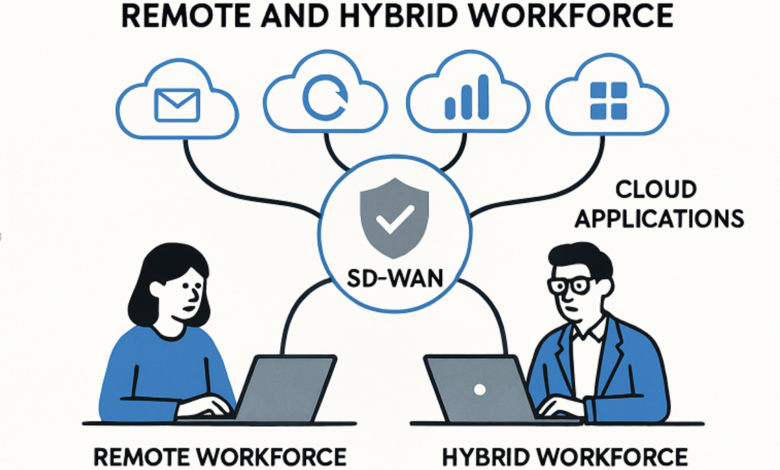How SD-WAN Is Powering the Modern Digital Workforce

In an era defined by rapid digital transformation and the proliferation of remote and hybrid work models, businesses across every industry are under pressure to provide reliable, flexible, and secure connectivity for a dispersed workforce. As employees expect seamless access to enterprise applications from any location—whether at home, in a branch office, or on the go—the stakes for high-performing, secure networking infrastructure have never been higher. SD-WAN (Software-Defined Wide Area Networking) has firmly established itself as a cornerstone technology for this new reality, enabling organizations to adapt quickly, protect sensitive data, and optimize user experiences. With the growing adoption of SaaS, real-time collaboration tools, and bandwidth-intensive applications, intelligent network solutions like SD-WAN are becoming indispensable for maintaining productivity, operational resilience, and competitive advantage.
SD-WAN fundamentally changes how enterprises build, secure, and manage their wide area networks by intelligently routing traffic, simplifying the integration of cloud applications, and centralizing network oversight. Instead of relying on rigid, hardware-centric architectures, SD-WAN software enables dynamic, policy-based traffic management that continually adapts to real-time network conditions. This agility not only improves end-user satisfaction but also reduces the complexity and overhead commonly associated with traditional networking. Businesses looking to stay ahead of digital trends, support an evolving workforce, and maximize the value of their technology investments are increasingly deploying SD-WAN solutions at the core of their operations.
Enhancing Network Performance
Traditional, hardware-bound WAN architectures are ill-equipped to handle the needs of the modern digital workplace, where cloud-driven workloads and bandwidth-intensive collaboration platforms are the norm. The increase in people working remotely has exposed the weaknesses of legacy networks, such as high latency, unpredictable throughput, and vulnerability to congestion, making it difficult to maintain productivity and application reliability. These deficiencies can significantly impact remote teams, especially when they rely on virtual desktops, streaming video meetings, or large-scale data transfers. As highlighted by BizTech Magazine, SD-WAN addresses these pain points by dynamically steering application traffic across multiple connection types, including MPLS, broadband, and LTE, based on current network performance and application priority. This adaptability ensures that business-critical workloads are always carried over the best available paths to minimize lag, packet loss, or interruptions.
Dynamic Path Selection
SD-WAN’s hallmark feature of dynamic path selection empowers businesses to prioritize high-value or latency-sensitive applications, ensuring they consistently receive adequate bandwidth and stable connectivity. Policies can be configured to detect and respond in real-time to congestion, outages, or fluctuations in network health, automatically rerouting traffic as needed. This keeps vital applications—such as voice, video, and ERP systems—running optimally, supports business continuity even during network disruptions, and creates a more predictable user experience for both on-site and remote staff.
Strengthening Security Measures
The blurring of corporate perimeters caused by remote and hybrid work means that sensitive data now flows across a wider variety of devices, locations, and networks than ever before—a shift that dramatically increases cybersecurity risks, from endpoint breaches to threats moving between branch offices and the cloud. According to AP News, U.S. cyber officials are urging organizations to “ensure that traffic is end‑to‑end encrypted to the maximum extent possible,” highlighting the critical importance of this protection in today’s environment. SD‑WAN addresses these risks at their source by building strong security features directly into the network fabric. End-to-end encryption ensures that data remains secure as it travels between users and cloud-based resources, whether employees are in the office, at home, or on public Wi-Fi. Meanwhile, network segmentation further fortifies defenses by isolating sensitive traffic and making it much harder for attackers to move laterally if a breach does occur.
See also: XRP Price USD: Should You Buy the Dip?
End-to-End Visibility and Policy Enforcement
SD-WAN’s security capabilities go beyond basic encryption. It provides unparalleled visibility into all network activity, enabling IT teams to monitor traffic flows, detect anomalies, and respond rapidly to potential threats. Sophisticated policy enforcement enables organizations to create highly granular controls tailored to specific roles, devices, and application types, thereby strengthening compliance with both internal requirements and regulatory standards. The adoption of a zero-trust approach—where every connection is authenticated regardless of source—provides an added layer of assurance, minimizing exposure to phishing, malware, and insider threats across all network environments.
Facilitating Cloud Integration
As organizations accelerate their shift to SaaS, IaaS, and multi-cloud environments, the need for direct, efficient, and secure cloud access becomes paramount. Traditional WAN approaches often force cloud-destined traffic through centralized data centers, which adds latency, reduces speed, and creates potential points of failure. SD-WAN disrupts this model by enabling direct-to-cloud connections from any branch or remote location, ensuring users experience fast and reliable access to critical applications without being bogged down by unnecessary detours.
Boosting Application Performance
Thanks to its intelligent path selection and policy-driven traffic management, SD-WAN delivers superior performance for cloud-based productivity suites and customer-facing applications. Organizations that leverage tools such as Microsoft 365, Google Workspace, and Salesforce benefit from smoother, more responsive user experiences, regardless of their users’ locations. By reducing latency and enhancing uptime, SD-WAN not only boosts employee performance but also supports business growth and innovation by empowering digital transformation initiatives that rely heavily on the cloud.
Simplifying Network Management
Managing the complexities of a distributed, cloud-centric network environment has traditionally required large IT teams and significant manual intervention. SD-WAN radically simplifies these operations through centralized, software-based control, enabling IT administrators to deploy, manage, and troubleshoot networks spanning multiple locations from a single-pane-of-glass dashboard. This enhanced visibility allows teams to instantly identify bottlenecks, automate routine maintenance, and implement enterprise-wide policies with minimal effort. Real-time monitoring and remote troubleshooting further streamline the process, reducing the risk of misconfiguration, minimizing downtime, and enabling a faster response to emerging issues.
Cost Efficiency and Scalability
One of the main advantages of SD-WAN lies in the cost efficiencies it brings. By leveraging broadband and wireless connections alongside traditional MPLS, organizations can shift critical workloads to the most cost-effective access methods without sacrificing performance. The ease of scaling up connectivity—whether rolling out new branch locations, onboarding remote employees, or integrating additional cloud applications—makes SD-WAN an ideal fit for fast-growing businesses. By automating repetitive tasks and centralizing policy management, IT resources are freed up to focus on strategic projects and innovation, ultimately driving long-term value for the organization.
Supporting Remote and Hybrid Workforces
The need for workplace flexibility has become a defining characteristic of modern employment. Employees, clients, and partners demand secure, high-speed access to resources, whether working from corporate headquarters, a branch location, a home office, or while traveling. SD-WAN provides consistent network performance and security policies across all endpoints, eliminating the gaps that often emerge when employees switch between various environments. This continuity enables companies to implement robust remote work strategies, meeting stringent compliance requirements and safeguarding both data and user privacy.
Enabling Collaboration and Business Continuity
Modern business continuity hinges on an organization’s ability to keep remote teams connected, collaborative, and productive even in the face of unexpected outages or usage spikes. With SD-WAN in place, enterprises can maintain real-time communication and secure data sharing, ensuring applications stay accessible and performance remains reliable throughout any disruption. This resiliency not only supports ongoing operations during crises but also strengthens the business by fostering an agile, connected culture that is ready to meet tomorrow’s challenges.
In summary, SD-WAN is revolutionizing the way businesses connect, secure, and empower their digital workforces today. By addressing the challenges of network performance, security, scalability, and cloud readiness, SD-WAN provides a robust foundation for organizations to thrive amid an ever-changing technological landscape.





